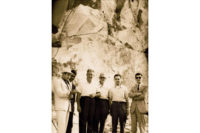As part of the City's $55 million renovation, the minimalist design by Norwegian architectural design firm Snohetta is grounding the neon fairyland of Times Square in granite and stainless steel. Dark pavers, minimalist granite benches and steel bollards will keep pedestrian traffic flowing along the edges of the square while keeping automobile traffic out. The streamlined design creates a calm quiet foundation for the colorful razzle-dazzle of the "Great White Way."
Jim Belilove of Creative Edge Mastershop in Fairfield, IA, had read about the reconstruction project and followed its progress on visits to his sister, a long-time resident of Manhattan, and his daughter, a student at Parsons The New School for Design. "After Mayor Mike Bloomberg ordered the streets of Times Square to be made into a temporary pedestrian plaza in 2009, my wife and I noticed that when we attended shows on Broadway, the congestion was a lot less," he said.
Belilove watched as New York City embarked on the second stage of the reconstruction -- making the pedestrian plazas permanent. Little did he know that his own waterjet fabrication firm would play a major role in creating a large-scale, in-the-pavement work of art at the heart of the Times Square reconstruction project. "When the phone call came from Dale Travis Associates asking us to fabricate the stylized map of the 40 Broadway theaters in Times Square, I couldn't help but feel a bit of a thrill," he said.
Located in Duffy Square, the triangular concrete park between West 46th and 47th streets that also is home to the TKTS booth and its red bleacher steps, the map was designed by Doyle Partners and Local Projects in conjunction with Snohetta and the graphics arts firm Dale Travis Associates. Embedded in the pavement between the statues of George Cohen and Father Duffy, after whom Duffy Square is named, the map turns out to be one of the last public works completed by the outgoing Bloomberg administration. The impressive 28-foot "Spotlight on Broadway" public artwork pinpoints the names and locations of the 40 Broadway theatres in granite and steel, and it was completed on December 15, 2013.
The choice of Creative Edge to fabricate the map made sense -- not only because Dale Travis had worked with the company on several graphic lettering projects, such as the showcase of New York City's tickertape parade history at the Canyon of Heroes and the Rose Center at the American Museum of Natural History -- but because the company has a track record in creating monumental public works of art. Belilove, who co-founded Creative Edge Mastershop in 1988 with fine artist Harri Aalto, has fabricated, and in some cases designed, public works of art such as the Astronauts Memorial at Kennedy Space Center, the Stan Musial outdoor memorial at Busch Stadium in St. Louis, MO, and the entrance to Disney World in Orlando, FL.
"We have a unique set of experiences working with metal and stone in graphics and public art," explained Belilove. "As a company, we not only have mastered the technology of waterjet, but have the vision to understand and realize the intent of the public artist."
Marrying granite and steel
Waterjet technology is perfectly suited to implementing the granite-and-steel design of the Spotlight on Broadway map. "Thirty-five years ago, the intricate shapes of the Spotlight on Broadway map could not be cut in granite and stainless steel," said Belilove. "If you tried to chisel the granite, it would break. Waterjet makes intricate designs in stone possible."
It turns out that metals such as stainless steel, used for the letters in the map, also have been liberated by waterjet technology. The heat is carried off by the water, providing a built-in self-cooling mechanism, Belilove explains. This allows waterjet to cut stainless steel, aluminum, copper and bronze without warping. "Shaping architectural metals became a possibility because there is no oxidation or burning of the metal when you use waterjet," he said.
One of the challenges in creating the 2-foot steel letters of the Broadway theaters to be permanently embedded in granite pavers was to make sure the metal wasn't going to be slippery to walk upon, according to Belilove. Creative Edge found help from Slipnot Metal Safety Flooring in Detroit, MI, which works with non-slip finishes for auto factory floors. "They helped create a non-slippery finish that would hold up with 375,000 people walking over it daily for the next 100 years," said Belilove. "There were a surprising amount of details to be thought through when creating something like this."







